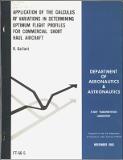Application of the calculus of variations in determining optimum flight profiles for commercial short haul aircraft
Author(s)
Gallant, Robert Alfred
DownloadFTL_R_1966_05.pdf (3.066Mb)
Other Contributors
United States. Office of High-Speed Ground Transportation
Massachusetts Institute of Technology. Flight Transportation Laboratory
Metadata
Show full item recordAbstract
The method of steepest descent of the calculus of variations is used to determine the optimal flight profile of a hypothetical tilt wing aircraft travelling a distance of 50 miles. Direct operating cost, (as derived from the ATA formulation) is minimized using aircraft lift coefficient and power as control variables each with upper and lower limits. Only the portion of the flight from the end of transition to the beginning of retransition was considered, with both initial and final values of velocity, flight path angle, and altitude specified. The results show that full power is used to accelerate and to climb at a speed about twice the value for maximum rate of climb. At 12000 feet, power is reduced to flight idle and a high speed, power off glide is made to destination. A rapid deceleration is made at low altitude to achieve the specified conditions for retransition. While the optimal profiles for velocity, altitude, and power are greatly different from the nominal profiles chosen to design the aircraft (Ref. 5), the optimal trip cost of $30.54 is only slightly less than the nominal trip cost of $31.60.
Description
December 1966 Includes bibliographical references (p. 52-53)
Date issued
1966Publisher
[Cambridge, Mass.] : Massachusetts Institute of Technology, Flight Transportation Laboratory, 1966
Other identifiers
06109428
Series/Report no.
FTL report (Massachusetts Institute of Technology. Flight Transportation Laboratory) ; R66-5
Keywords
Calculus of variations, Vertically rising aircraft, Aeronautics, Commercial, Passenger traffic, Mathematical models